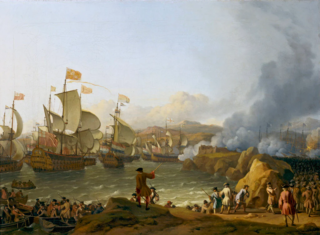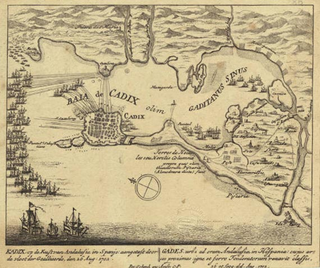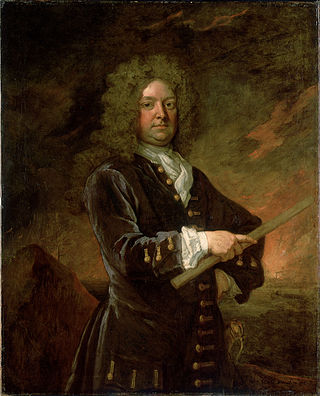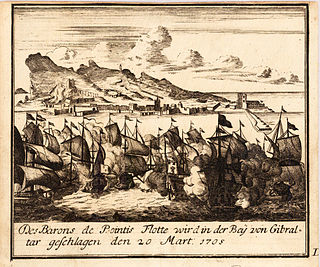
Admiral of the Fleet Sir George Rooke was an English naval officer. As a junior officer he saw action at the Battle of Solebay and again at the Battle of Schooneveld during the Third Anglo-Dutch War. As a captain, he conveyed Prince William of Orange to England and took part in the Battle of Bantry Bay during the Williamite War in Ireland.

The Anglo-Spanish War was a conflict between the English Protectorate under Oliver Cromwell, and Spain, between 1654 and 1660. It was caused by commercial rivalry. Each side attacked the other's commercial and colonial interests in various ways such as privateering and naval expeditions. In 1655, an English amphibious expedition invaded Spanish territory in the Caribbean. In 1657, England formed an alliance with France, merging the Anglo–Spanish war with the larger Franco-Spanish War resulting in major land actions that took place in the Spanish Netherlands.

The Battle of Vigo Bay, also known as the Battle of Rande, was a naval engagement fought on 23 October 1702 during the opening years of the War of the Spanish Succession. The engagement followed an Anglo-Dutch attempt to capture the Spanish port of Cádiz in September in an effort to secure a naval base in the Iberian Peninsula. From this station the Allies had hoped to conduct operations in the western Mediterranean Sea, particularly against the French at Toulon. The amphibious assault, however, had proved a disaster, but as Admiral George Rooke retreated home in early October, he received news that the Spanish treasure fleet from America, laden with silver and merchandise, had entered Vigo Bay in northern Spain. Philips van Almonde convinced Rooke to attack the treasure ships, despite the lateness of the year and the fact that the vessels were protected by French ships-of-the-line.
Several engagements near the port of Cádiz in Spain are known as the Battle of Cádiz:
HMS Somerset was a three-decker 80-gun third rate ship of the line of the Royal Navy, launched at Chatham Dockyard on 31 May 1698. She was the first ship to bear the name.

Francisco Castillo Fajardo, 2nd Marquis of Villadarias, was a Spanish general.

The Battle of Cádiz, fought in August/September 1702, was an Anglo-Dutch attempt to seize the southern Spanish port of Cádiz during the War of the Spanish Succession. The Andalusian city of Cádiz was the great European centre of the Spanish–American trade. The port's capture would not only help to sever Spain's links with her empire in the Americas, but it would also provide the Allies with a strategically important base from which the Anglo-Dutch fleets could control the western Mediterranean Sea.

Admiral of the Fleet Sir John Leake was a Royal Navy officer and politician. As a junior officer he saw action at the Battle of Texel during the Third Anglo-Dutch War. He then distinguished himself when he led the convoy that broke the barricading boom at Culmore Fort thereby lifting the siege of Derry during the Williamite War in Ireland. As a captain he saw action in some of the heaviest fighting at the Battle of Barfleur and was also involved in a successful attack on the French ships at the Battle of La Hogue during the Nine Years' War.

The Battle of Cabrita Point, also known Battle of Marbella, was a naval battle that took place while a combined Spanish-French force besieged Gibraltar on 10 March 1705 during the War of Spanish Succession. The battle ended in an allied victory which effectively ended the Franco-Spanish siege of Gibraltar.

HMS Warspite was a 70-gun third-rate ship of the line of the Royal Navy, launched in 1666 at Blackwall Yard. This second Warspite was one of the five ships designed to carry more provisions and lower deck guns higher above the water than French and Dutch equivalents. In 1665 the Second Anglo-Dutch War had begun and on 25 July 1666 Warspite was one of 23 new English warships helping to beat a Dutch fleet off North Foreland, Kent. She won again distinction on Christmas Day 1666 as senior officer's ship out of five sent to protect an important convoy of naval stores from the Baltic. Warspite next took part in the first action of the Third Anglo-Dutch War on 28 May 1672 off Southwold Bay, Suffolk. This desperate 14-hour battle, generally known as Solebay, was a drawn fight; but Warspite successfully fended off a pair of Dutch fire ships exactly as she had done off North Foreland. By 1685, she was mounting only 68 guns.

The Anglo-Spanish War was fought between 1796 and 1802, and again from 1804 to 1808, as part of the Coalition Wars. The war ended when an alliance was signed between Great Britain and Spain, which was now under French invasion.

The Capture of Gibraltar by Anglo-Dutch forces of the Grand Alliance occurred between 1 and 4 August 1704 during the War of the Spanish Succession. Since the beginning of the war the Alliance had been looking for a harbour in the Iberian Peninsula to control the Strait of Gibraltar and facilitate naval operations against the French fleet in the western Mediterranean Sea. An attempt to seize Cádiz had ended in failure in September 1702, but following the Alliance fleet's successful raid in Vigo Bay in October that year, the combined fleets of the 'Maritime Powers', the Netherlands and England, had emerged as the dominant naval force in the region. This strength helped persuade King Peter II of Portugal to sever his alliance with France and Bourbon-controlled Spain, and ally himself with the Grand Alliance in 1703 as the Alliance fleets could campaign in the Mediterranean using access to the port of Lisbon and conduct operations in support of the Austrian Habsburg candidate to the Spanish throne, the Archduke Charles, known to his supporters as Charles III of Spain.

The Capture of Minorca saw the island of Menorca captured from Spain by British-Dutch forces acting on behalf of Charles VI, Holy Roman Emperor the Austrian claimant to the Spanish throne in September 1708 during the War of the Spanish Succession. The British would later annex the island as their own possession at the Treaty of Utrecht (1713).

The siege of Barcelona took place between 14 September and 19 October 1705 during the War of the Spanish Succession when a multinational Grand Alliance army led by Lord Peterborough, supporting the Habsburg pretender to the Spanish throne, captured the city of Barcelona from its Spanish Bourbonic defenders, most of whom then joined the Habsburg army.

Simón Rodríguez Susarte, commonly known as Simón Susarte, was a Spanish goatherd from Gibraltar, who in 1704 aided a Bourbon Spanish attempt to seize Gibraltar during the Twelfth Siege of Gibraltar by revealing a concealed path to the attackers which led to the top of the Rock of Gibraltar. Susarte then guided a Bourbon contingent along this difficult trail, aiming to surprise the Grand Alliance garrison in hopes of recovering the town.
The action of 19 December 1796 was a minor naval engagement of the French Revolutionary Wars, fought in the last stages of the Mediterranean campaign between two British Royal Navy frigates and two Spanish Navy frigates off the coast of Murcia. The British squadron was the last remaining British naval force in the Mediterranean, sent to transport the British garrison of Elba to safety under the command of Commodore Horatio Nelson. The Spanish under Commodore Don Jacobo Stuart were the vanguard of a much larger squadron. One Spanish frigate was captured and another damaged before Spanish reinforcements drove the British off and recaptured the lost ship.

The history of Gibraltar, a small peninsula on the southern Iberian coast near the entrance of the Mediterranean Sea, spans over 2,900 years. The peninsula has evolved from a place of reverence in ancient times into "one of the most densely fortified and fought-over places in Europe", as one historian has put it. Gibraltar's location has given it an outsized significance in the history of Europe and its fortified town, established in the Middle Ages, has hosted garrisons that sustained numerous sieges and battles over the centuries.

The action of 13 October 1796 was a minor naval engagement of the French Revolutionary Wars, fought off the Mediterranean coast of Spain near Cartagena between the British Royal Navy 32-gun frigate HMS Terpsichore under Captain Richard Bowen and the Spanish Navy 34-gun frigate Mahonesa under Captain Tomás de Ayalde. The action was the first battle of the Anglo-Spanish War, coming just eight days after the Spanish declaration of war. In a battle lasting an hour and forty minutes, Mahonesa was captured.

The twelfth siege of Gibraltar was fought between September 1704 and May 1705 during the War of the Spanish Succession. It followed the capture in August 1704 of the fortified town of Gibraltar, at the southern tip of Spain, by an Anglo–Dutch naval force led by Sir George Rooke and Prince George of Hesse-Darmstadt. The members of the Grand Alliance, the Holy Roman Empire, England, the Netherlands, Pro-Habsburg Spain, Portugal and Savoy, had allied to prevent the unification of the French and Spanish thrones by supporting the claim of the Habsburg pretender Archduke Charles VI of Austria as Charles III of Spain. They were opposed by the rival claimant, the Bourbon Philip, Duke of Anjou, ruling as Philip V of Spain, and his patron and ally, Louis XIV of France. The war began in northern Europe and was largely contained there until 1703, when Portugal joined the confederate powers. From then, English naval attentions were focused on mounting a campaign in the Mediterranean to distract the French navy and disrupt French and Bourbon Spanish shipping or capture a port for use as a naval base. The capture of Gibraltar was the outcome of that initial stage of the Mediterranean campaign.

The Mediterranean campaign of 1793–1796 was a major theater of conflict in the early years of the French Revolutionary Wars. Fought during the War of the First Coalition, the campaign was primarily contested in the Western Mediterranean between the French Navy's Mediterranean Fleet, based at Toulon in Southern France, and the British Royal Navy's Mediterranean Fleet, supported by the Spanish Navy and the smaller navies of several Italian states. Major fighting was concentrated in the Ligurian Sea, and focused on British maintenance of and French resistance to a British close blockade of the French Mediterranean coast. Additional conflict spread along Mediterranean trade routes, contested by individual warships and small squadrons.




















